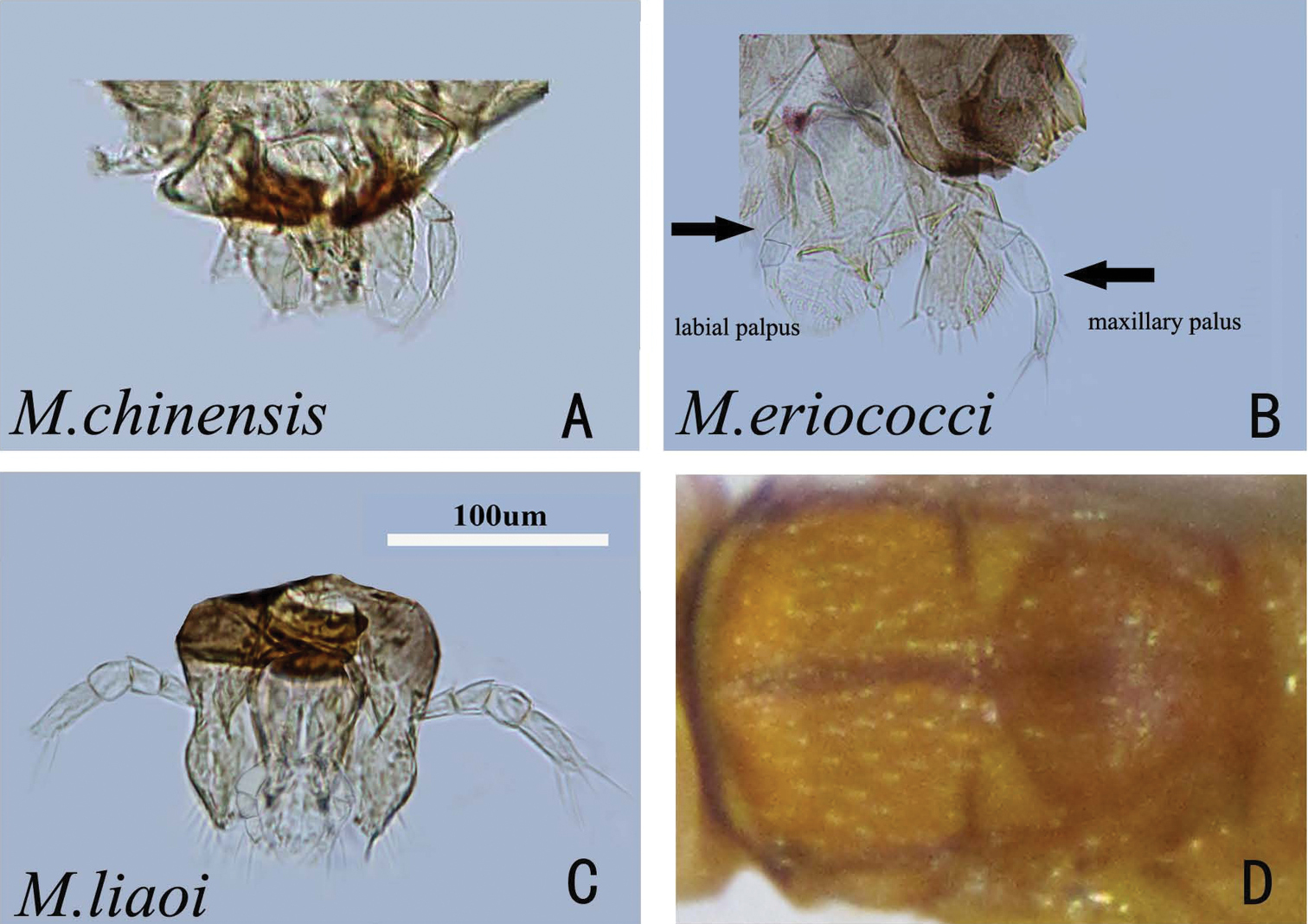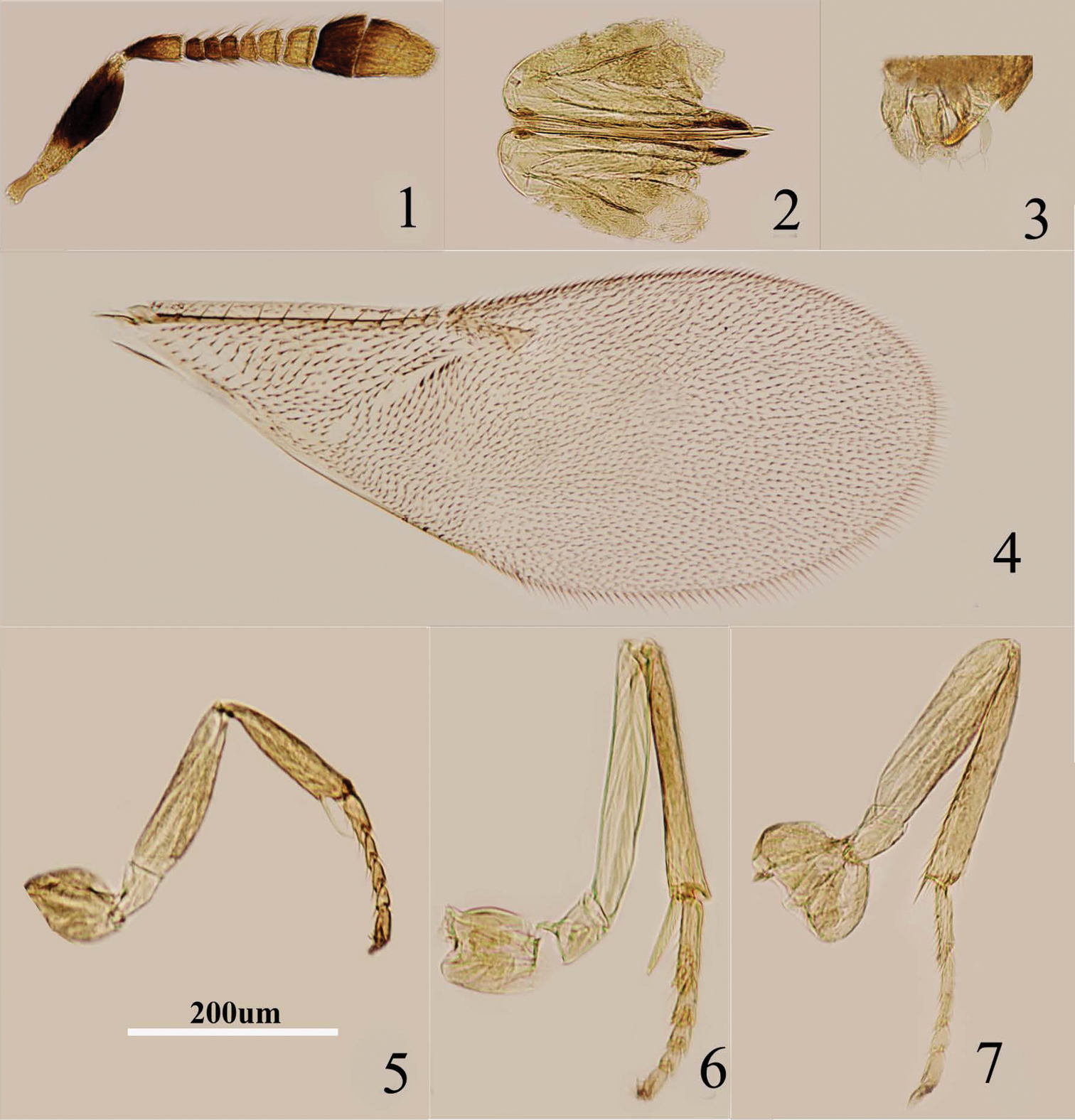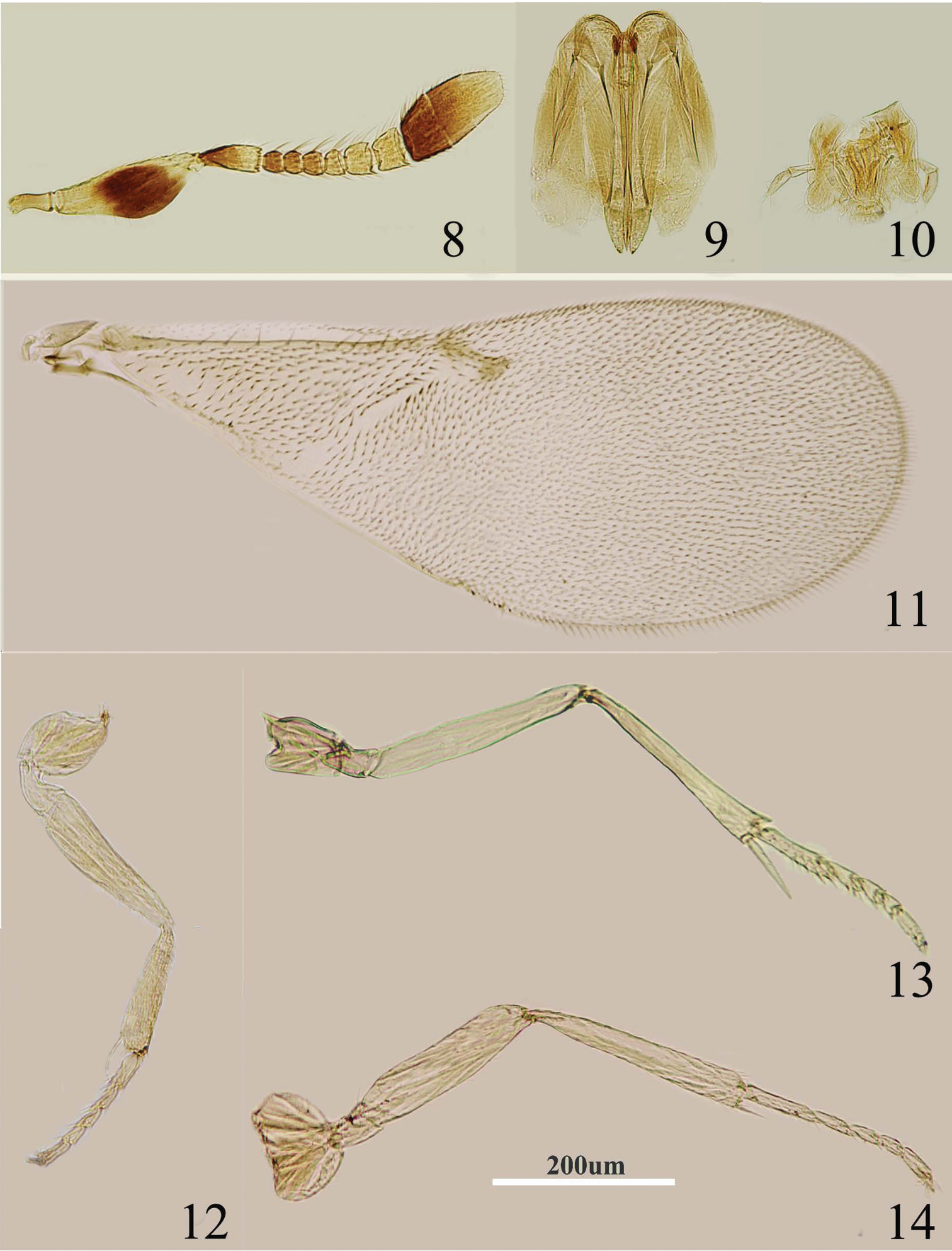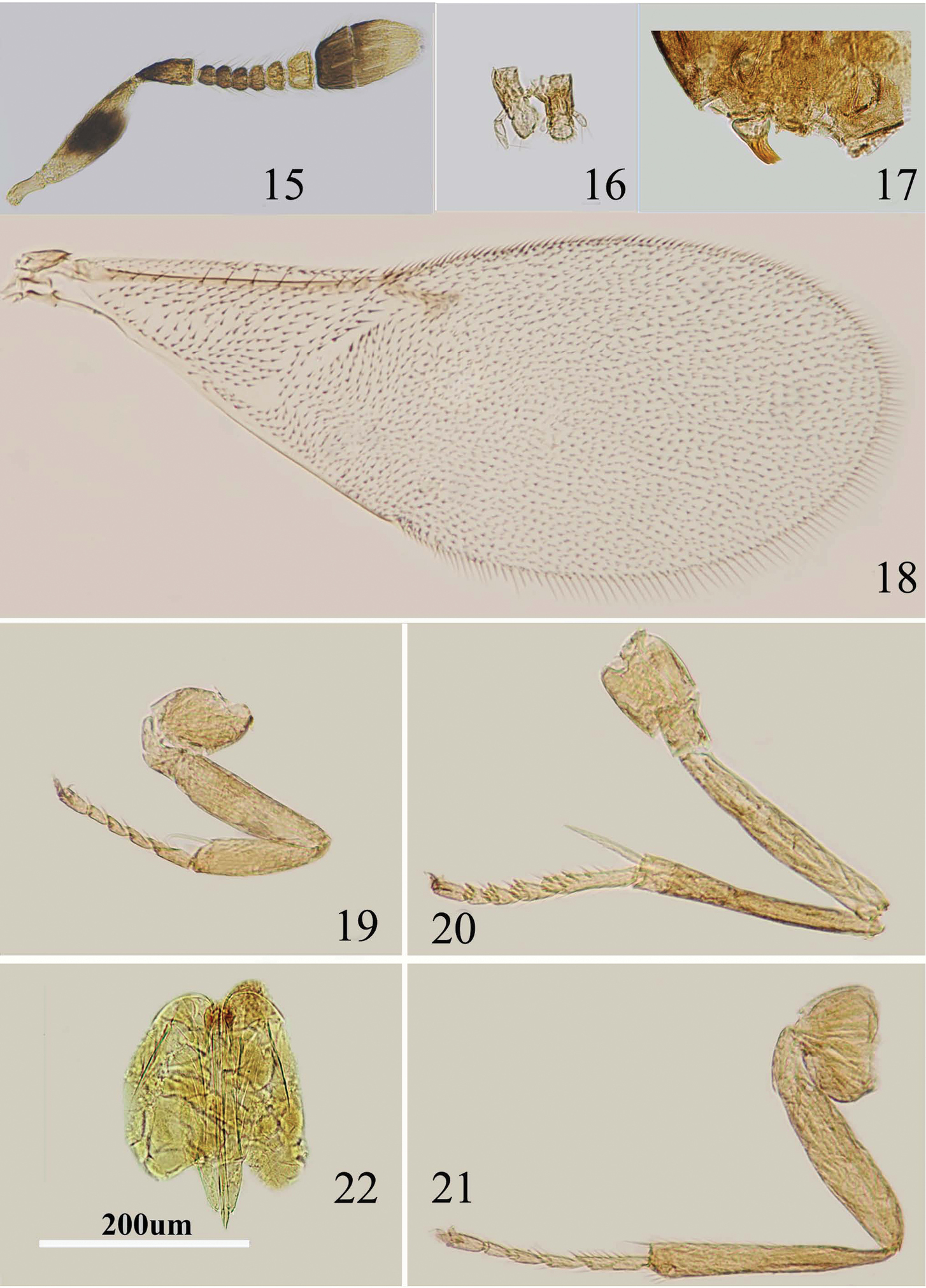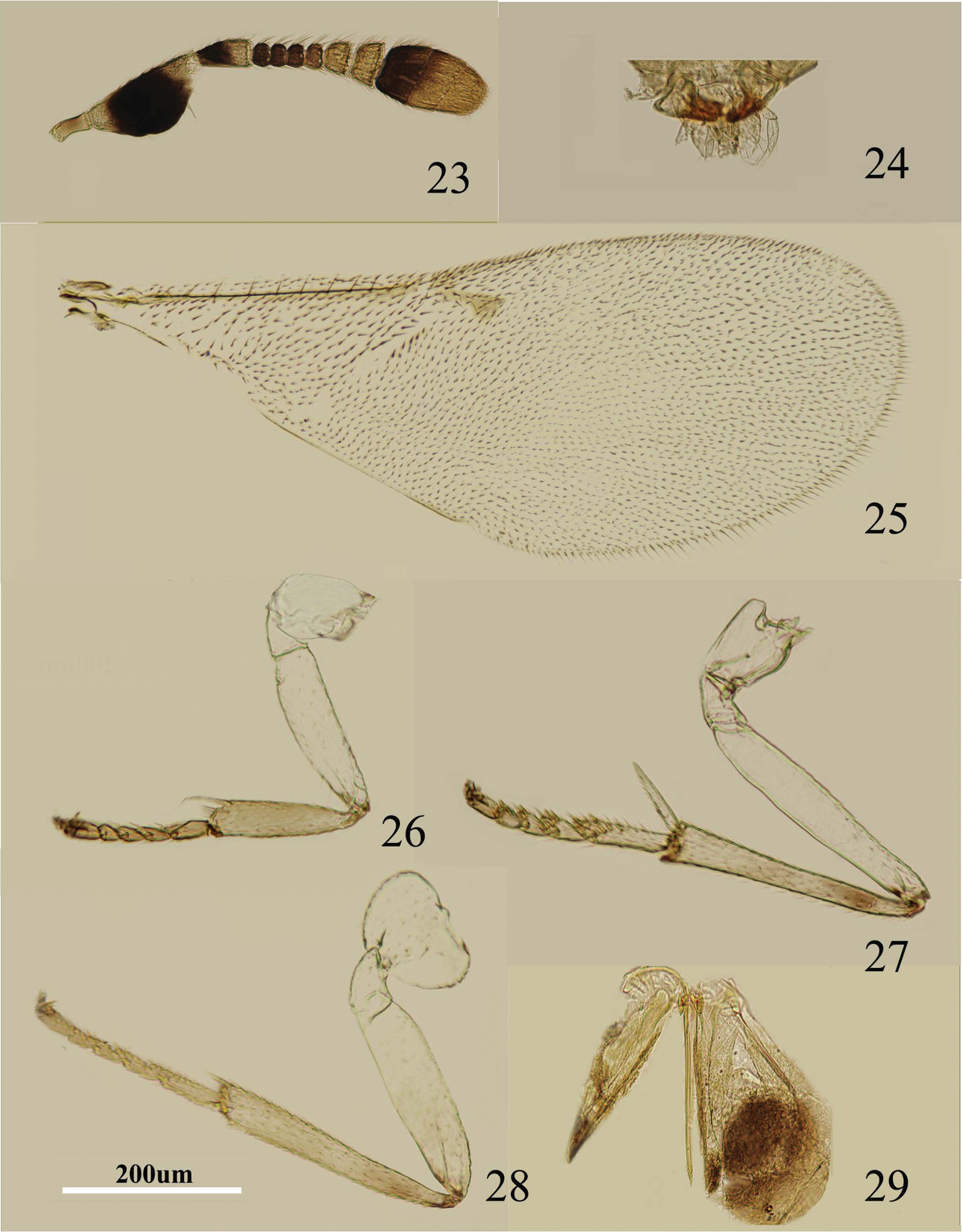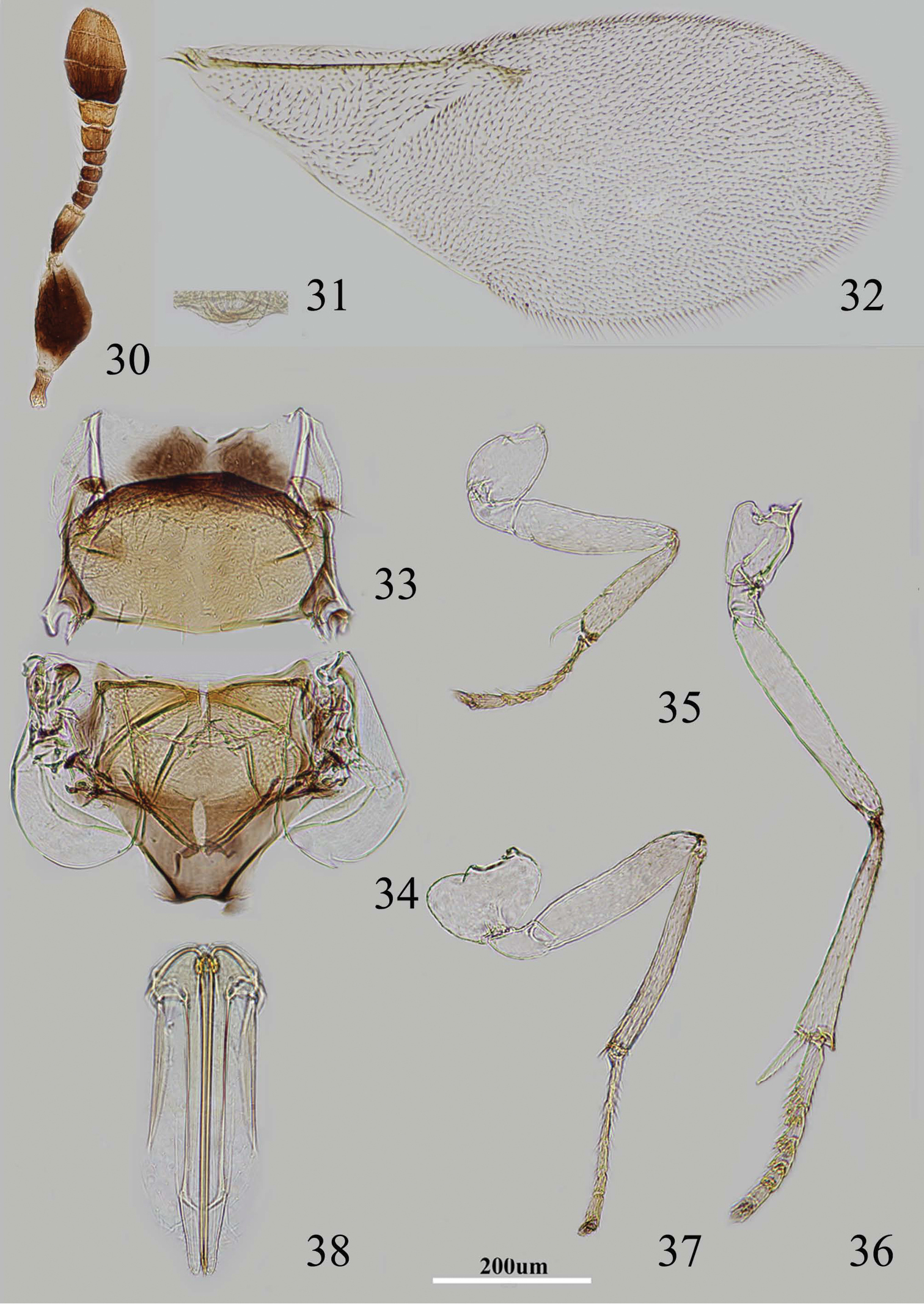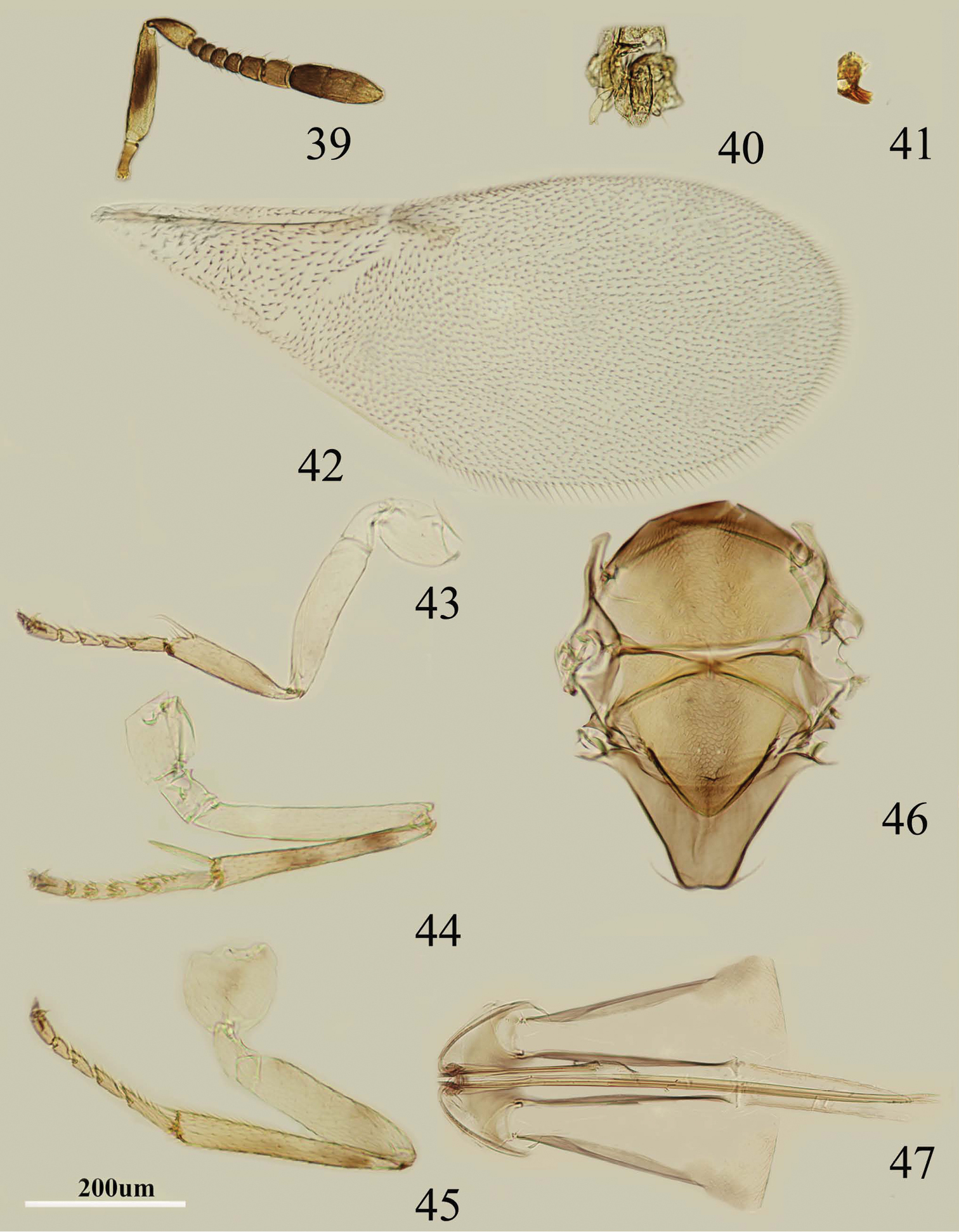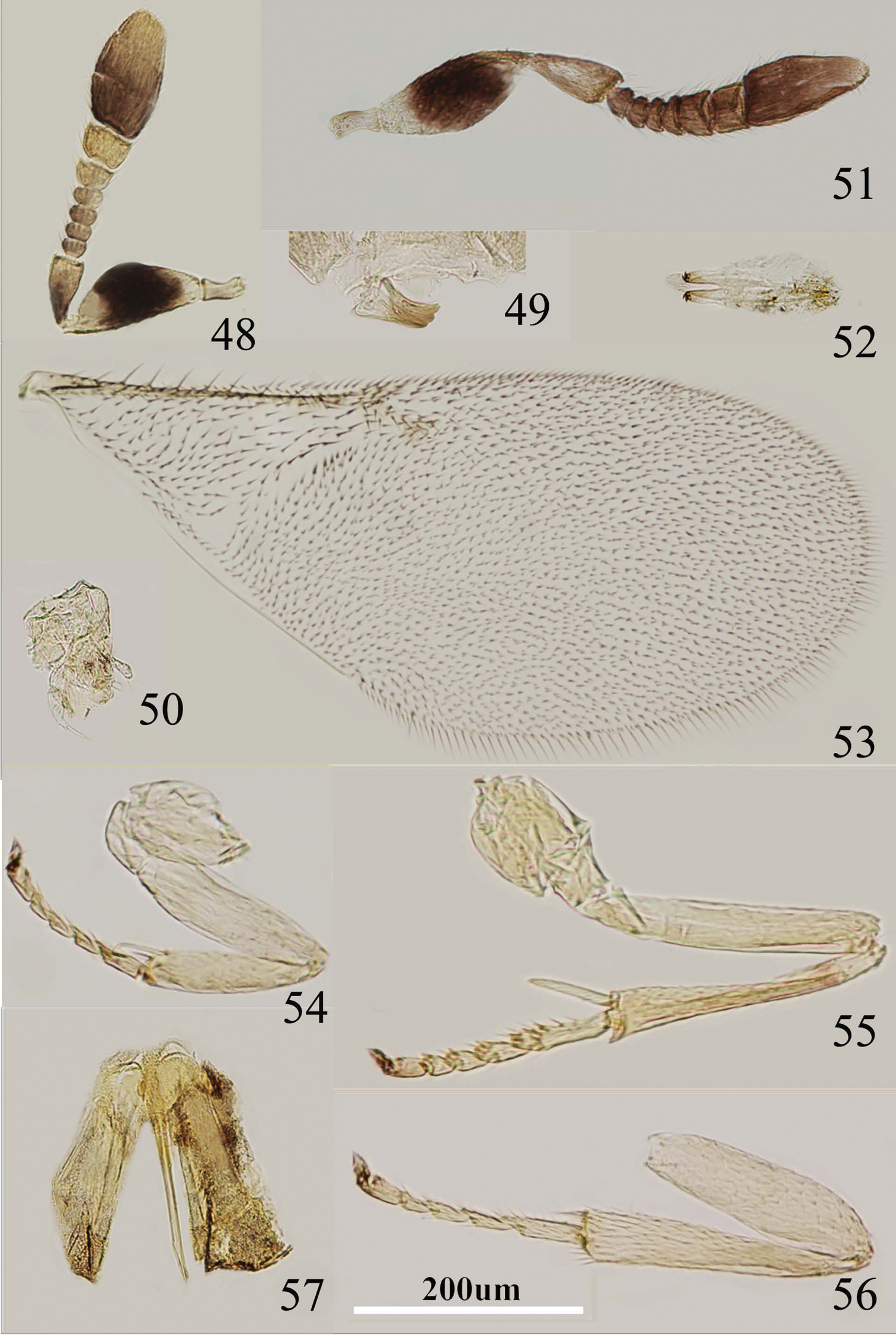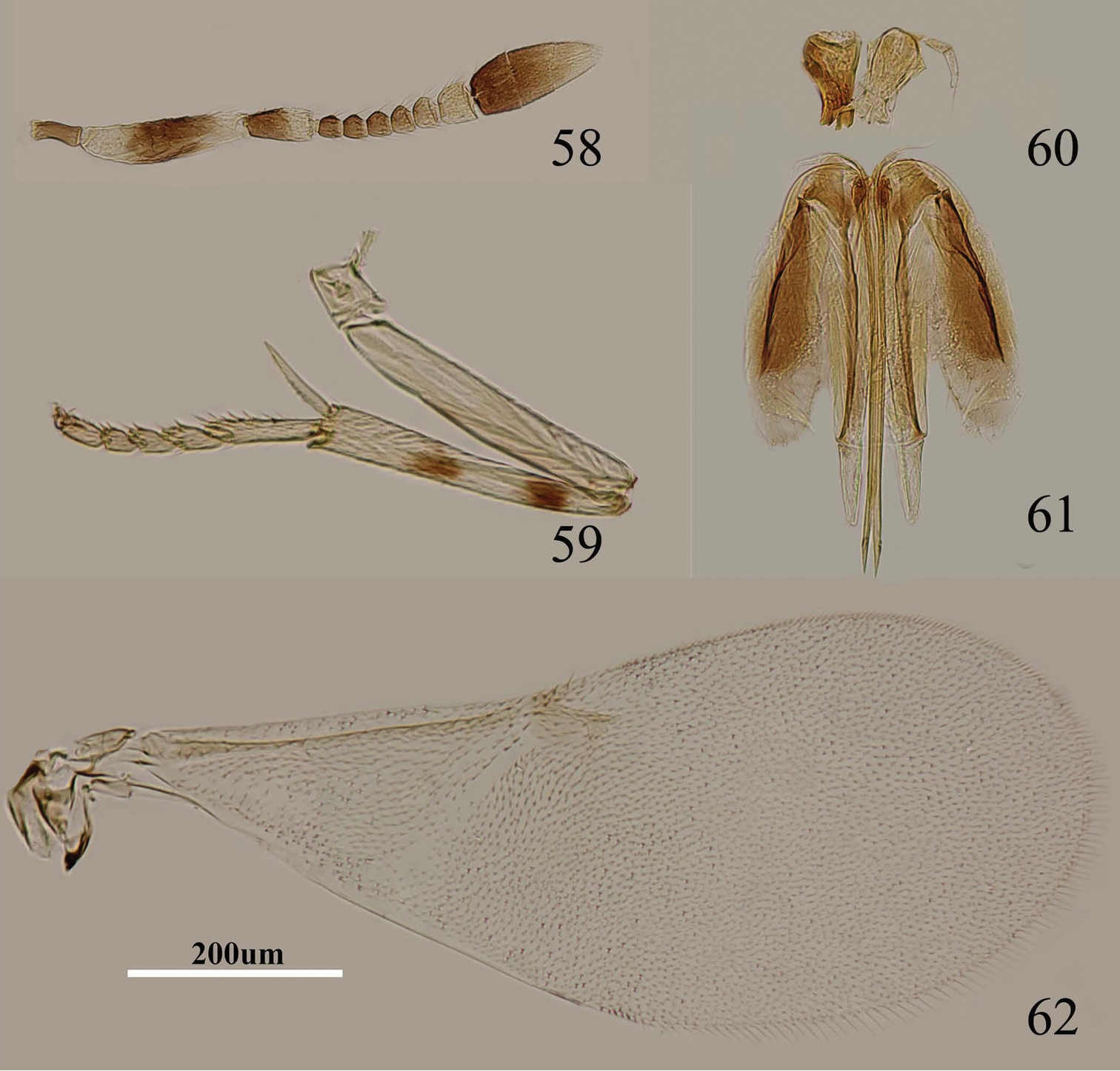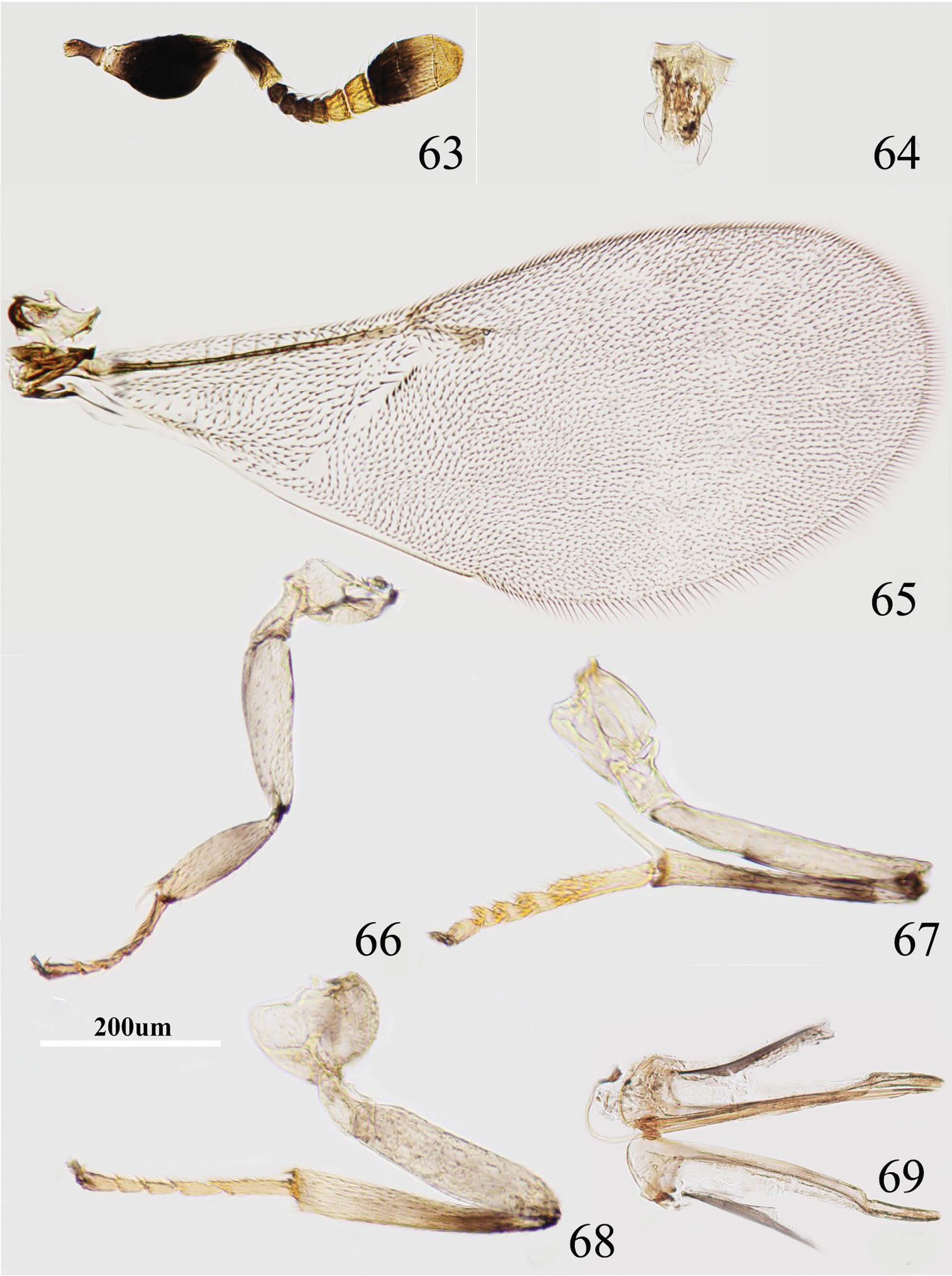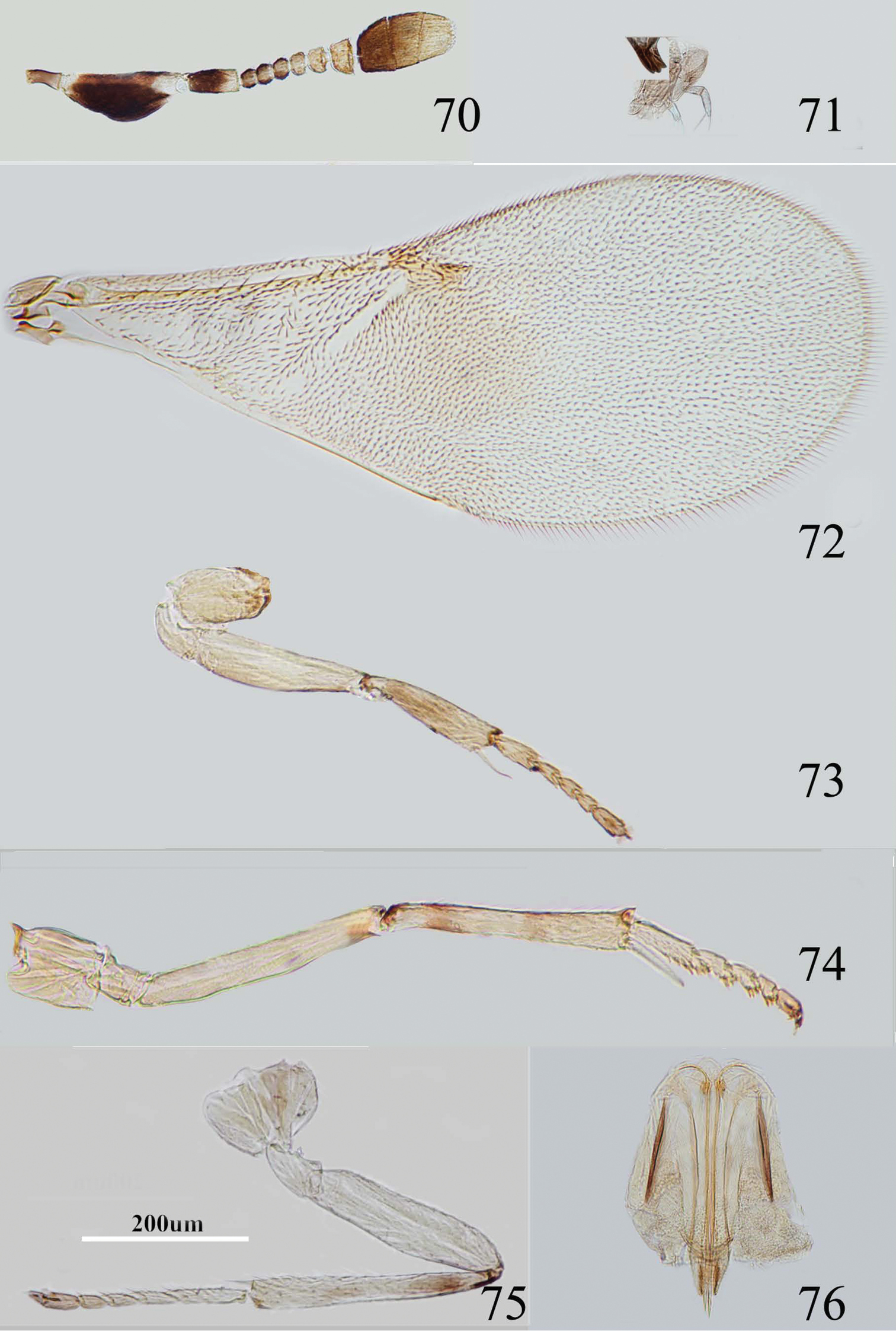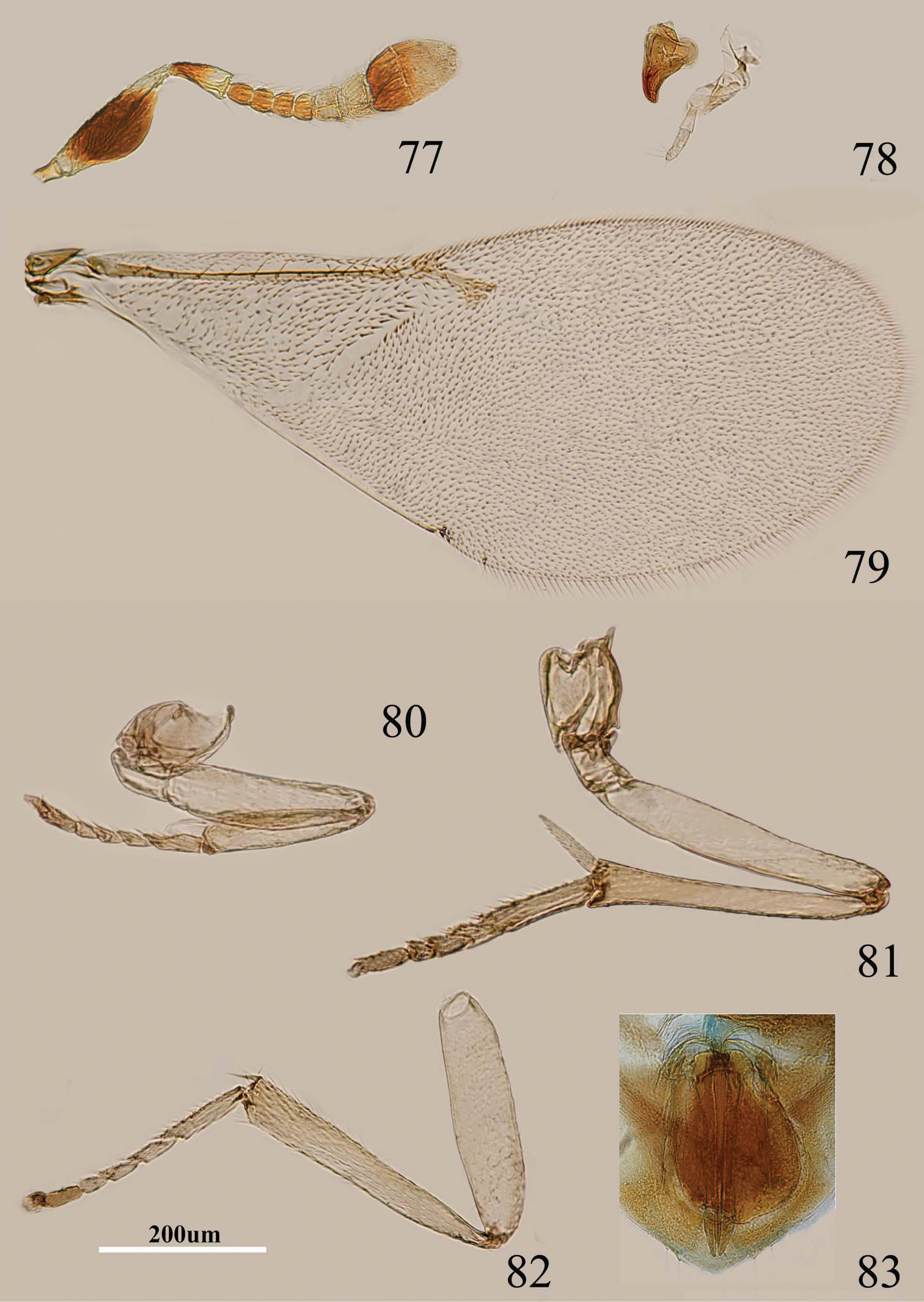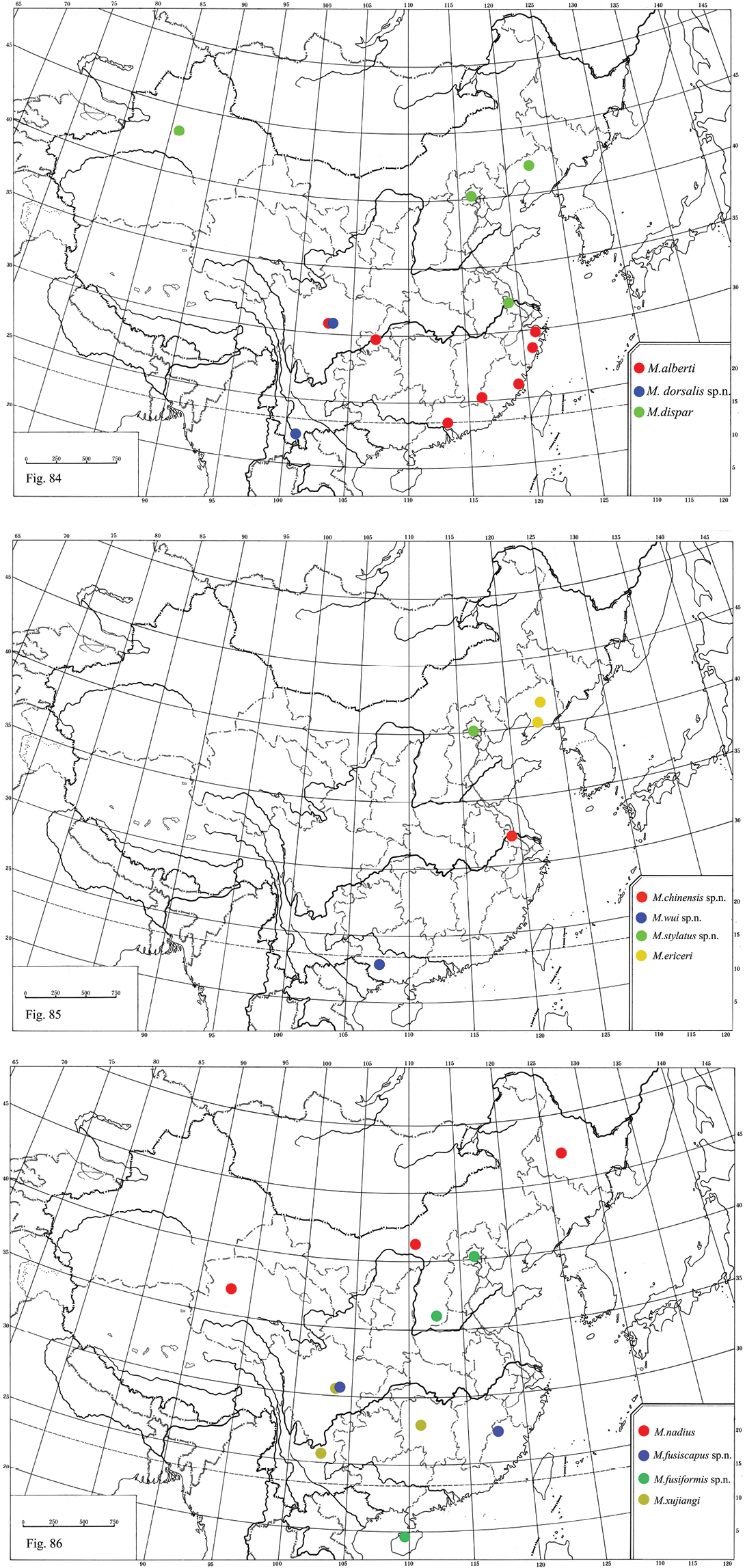






(C) 2013 Ying Wang. This is an open access article distributed under the terms of the Creative Commons Attribution License 3.0 (CC-BY), which permits unrestricted use, distribution, and reproduction in any medium, provided the original author and source are credited.
For reference, use of the paginated PDF or printed version of this article is recommended.
Ten alberti-group species of the genus Metaphycus Mercet from China are reviewed. Six species Metaphycus dorsalis sp. n., Metaphycus chinensis sp. n., Metaphycus wui sp. n., Metaphycus stylatus sp. n., Metaphycus fusiscapus sp. n. and Metaphycus fusiformis sp. n. are described as new to science. Four known species from China are redescribed. A key to the females of the Chinese species is given and photomicrographs are provided to illustrate morphological characters of these species. All specimens unless otherwise specified are deposited in the National Zoological Museum of China Institute of Zoology Chinese Academy of Sciences Beijing.
Chalcidoidea, parasitoids, natural enemy, new species, China
Metaphycus is a large genus of the family Encyrtidae, including 455 species worldwide (
Due to the economical and particularly the extraordinary diversification of Metaphycus, many taxonomic works have been published and a few good keys have been presented for the regional species of Metaphycus (
The Chinese fauna of Metaphycus is poorly known, though some taxonomic contributions (
Accurate identification of Metaphycus species is very difficult because of their small size and general appearance (
Morphological terminology and abbreviations follow those of
F1, F2, … Fn Funicle segment number
AOD Largest diameter of anterior ocellus
HW Head width measured in facial view
FV Minimum width of the frontovertex
FVL Length of frontovertex from occipital margin to top of antennal scrobes as seen in dorsal view
MS Malar space or the minimum distance between eye and mouth margin
POL The minimum distance between the posterior ocelli
OCL The minimum distance between the posterior ocellus and the occipital margin
AOL The minimum distance between posterior ocellus and anterior ocellus
OOL The minimum distance between the eye margin and the adjacent posterior ocellus
POD Largest diameter of posterior ocellus
EL The maximum diameter of eye
EW The minimum diameter of eye
SL The length of the scape
SW The maximum width of the scape
FWL Length of fore wing excluding the marginal fringe
FWW The maximum width of the fore wing excluding the marginal fringe
HWL Length of hind wing, excluding the marginal fringe
HWW Width of hind wing, measured at the widest point, excluding the marginal fringe
MT Length of the mid tibia
OL Length of ovipositor
GL Length of the gonostylus
BMNH Natural History Museum, London, UK
ICZN International Commission of Zoological Nomenclature
IZCAS Institute of Zoology, Chinese Academy of Sciences, Beijing, PR China
USNM United States National Museum, Washington, DC, USA
ZJU Zhejiang University, Hangzhou, China
SCU Sichuang University, Chengdu, China
KYUN Kyoto University, Kyoto, Japan
Aenasioidea Girault, 1911: 171. Type species: Aenasioidea latiscapus Girault, by original designation. Synonymy by
Metaphycus Mercet, 1917: 138. Type species: Aphycus zebratus Mercet, by monotypy.
Tyndarichoides Girault, 1920: 189. Type species: Tyndarichoides mexicanus Girault, by monotypy. Synonymy by
Euaphycus Mercet, 1921: 97. Type species: Encyrtus hederaceus Westwood, by subsequent designation of
Metaphycus Mercet, 1925: 28. Generic status.
Mercetiella Dozier, 1926: 98. Type species: Mercetiella reticulata Dozier, by original designation. Synonymy by
Oaphycus Giraiult, 1932: 5. Type species: Aphycus sanguinithorax Girault, by original designation. Synonymy by
Erythraphycus Compere, 1947: 7. Type species: Erythraphycus argyrocomus Compere, by original designation. Synonymy by
Melanphycus Compere, 1947: 5. Type species: Pseudococcobius fumipennis Timberlake, by original designation. Synonymy by
Anaphycus Sugonjaev, 1960: 372. Type species: Aphycus nitens Kurdjumov, by original designation. Synonymy by
Mesaphycus Sugonjaev, 1960: 370. Type species: Aphycus picearum Erdős, by original designation. Synonymy by
Notoencyrtus De Santis, 1964: 211. Type species: Notoencyrtus guttofasciatus De Santis, by original designation. Synonymy by
Xenaphycus Sharkov & Voynovich, 1988: 826. Type species: Paraphycus flavovarius Mercet, by subsequent designation of
Aenigmaphycus Sharkov & Voynovich, 1988: 826. Type species: Aenigmaphycus paluster Sharkov & Voynovich, by monotypy. Synonymy by
Diagnosis. Length 0.7–1.8 mm; robust and squat species; body largely orange, yellow to brown or black (the latter at maximum shiny), never with metallic luster, antenna usually with black and white or yellow segments, fore wing hyaline or partially infuscate, legs mostly yellowish, sometimes tibiae with dark rings. Head with occipital margin sharp; mandible mostly broad with 3 short, subequal teeth. Pronotum short, mesoscutum wider than long, notaular lines variable in length from virtually absent to reaching about 0.7× across mesoscutum; fore wing generally about 2.1–2.7× as long as broad and with uniform setation, postmarginal vein very short, stigmal vein well developed, longer than marginal and postmarginal vein together; linea calva usually closed and interrupted in posterior third by a few setae. Female: antenna almost always 11-segmented (formula 1163: 1 scape, 1 pedicel, 6 funicle, 3 clava). Gaster with hypopygium reaching half way along gaster to more or less reaching its apex; ovipositor sheath free, in most cases not exserted or only slightly exserted in Metaphycus stylatus sp. n. Male: generally darker and with more uniform colour in respect to that of corresponding female. Antenna 9-segmented (formula 1161: 1 scape, 1 pedicel, 6 funicle, 1 clava).
| 1 | Scape (Figs 39, |
2 |
| – | Scape (e.g. Figs 15, |
3 |
| 2 | Fore wing (Fig. 42) hyaline, without a small infuscate area beneath stigma vein; ovipositor sheath strongly exserted and about 0.4× as long as ovipositor (Fig. 47) | Metaphycus stylatus sp. n. |
| – | Fore wing (Fig. 62) hyaline, with a small infuscate area beneath stigma vein; ovipositor sheath clearly exserted but only about 0.25× as long as ovipositor (Fig. 61) | Metaphycus nadius (Walker, 1838) |
| 3 | Scape (Figs 1, |
4 |
| – | Scape (e.g. Figs 23, |
6 |
| 4 | Scape (Fig. 8) with a completely pale yellow dorsal margin, usually 3× as long as broad | Metaphycus alberti (Howard, 1898) |
| – | Scape (Fig. 1) with dorsal margin not completely pale yellow | 5 |
| 5 | Mesoscutum and scutellum with a longitudinal dark brown strip medially (Plate I–D) | Metaphycus dorsalis sp. n. |
| – | Mesoscutum and scutellum without a dark brown longitudinal strip | Metaphycus dispar (Mercet, 1925) |
| 6 | Scape (Fig. 70) with completely pale yellow dorsal margin, usually 2.4× as long as broad | Metaphycus fusiformis sp. n. |
| – | Scape (e.g. Figs 23, |
7 |
| 7 | Ovipositor longer than mid tibiae | 8 |
| – | Ovipositor shorter than mid tibiae | 9 |
| 8 | Mid and hind tibiae with distinct dark brown brown marking (Fig. 67); scape (Fig. 63) about 2× as long as broad | Metaphycus fusiscapus sp. n. |
| – | Mid and hind tibiae immaculate (Fig. 36), at most with a fuscous spot near base of mid tibiae; scape (Fig. 30) 2.3× as long as broad | Metaphycus wui sp. n. |
| 9 | F1–F3 subquadrate, not distinctly transverse; clava clearly shorter than scape, about 0.6× as long as scape (Fig. 77) | Metaphycus xujiangi Özdikmen, 2011 |
| – | F1–F3 distinctly transverse; clava about as long as scape (Figs 23, |
10 |
| 10 | Fore wing 2.4× as long as broad (Fig. 53), ocelli forming an angle of about 50°; ovipositor (Fig. 57) about 5.4× as long as ovipositor sheath | Metaphycus ericeri Trjapitzin, 1967 |
| – | Fore wing 2.7× as long as broad (Fig. 25), ocelli forming an angle of about 40°; ovipositor (Fig. 29) about 4.8× as long as ovipositor sheath | Metaphycus chinensis sp. n. |
urn:lsid:zoobank.org:act:486A67C0-EE88-4D7C-988A-47ABE6CB1712
http://species-id.net/wiki/Metaphycus_dorsalis
Plate 1D, Figs 1–7♀, China, Yunnan, Xishuangbanna: 2009.XI.9, Coll. G. Tang (IZCAS).
2♀♀, the same as holotype; 2♀♀, 1♂, Sichuan, Chengdu, 1961.VII.1–5, Coll. D. X. Liao (IZCAS).
Female: Body length, including ovipositor about 1mm. Frontovertex orange; orange in ocellar area, pale orange between occipital margin and posterior ocelli; immaculate with yellow from occiput to base of mandible; mouth margin medially yellow below torulus; rest of head, except occiput, white; antenna (Fig. 1) with radicle dark brown; scape with both faces dark brown, blackish, only base and apex white; pedicel dark brown in proximal one third, otherwise white; F1–F3 dark brown, F4 very pale brown, F5–F6 white, clava dark brown, becoming slightly paler towards apex, apex very pale brown; occiput with a brown area above foramen, rest white; neck of pronotum dark brown, posterior margin white, lateral spots relatively large and distinct; dorsum of thorax orange; sides and posterior margin of mesoscutum and axillae conspicuously bordered brown, mesoscutum and scutellum (Plate I–D) with brown line from front edge of mesoscutum to apex of scutellum; setae translucent pale brown, silvery in most lights; tegula white with apex pale brown; metanotum orange; mesopleuron yellow; prosternum and mesosternum pale yellow; legs (Figs 5–7) pale yellow; fore wing (Fig. 4) hyaline and with linea calva interrupted; venation yellow-brown; hind wing hyaline; propodeum medially orange-brown, laterally pale yellow; gaster orange and ovipositor sheath orange.
Head with polygonally reticulate sculpture and mesh size slightly less than that of one eye facet; frontovertex about one-fourth head width; ocelli forming an acute angle about 30°; eye not quite reaching occipital margin, separated by much less than diameter of a facet; frontovertex subparallel and from anterior ocellus slightly wider anteriorly; scrobes shallow and U-shaped; antenna with scape about 3–3.1× as long as broad; funicle with F1–F4 smallest, F5 a little larger than F4 but transverse, F6 largest and slightly wider than long; linear sensilla only on F5 and F6; clava 3-segmented, its apex more or less rounded but with a short slightly oblique truncation; mandible relatively broad with three subequal, apical teeth; palpal formula 2-2 (Fig. 3), notaular lines reaching about 0.4× across mesoscutum; fore wing venation and setation as in Fig. 4; ovipositor (Fig. 2) slightly exserted, about 5.6× as long as ovipositor sheath.
Relative measurements: HW 13, FV 3, FVL 7, POL 1.5, AOL 3.5, OOL 0.5, OCL 2, POD 1, AOD 1, EL 9, EW 6, MS 5, SL 6, SW 2, FWL 35, FWW 14, HWL 23, HWW 5, OL 10, GL 2, MT 10.
Male. Unknown.
Unknown.
China (Sichuan, Yunnan).
The specific epithet of this new species refers to the medial longitudinal dark brown strip on the mesoscutum and scutellum.
Antenna with scape about 3–3.1× as long as broad; mesoscutum and scutellum with brown line running from front edge of mesoscutum to apex of scutellum; legs pale yellow; fore wing hyaline and with linea calva interrupted. Using the keys of
A palpal formula 2-2 (Metaphycus chinensis sp. n.) B palpal formula 3-3 (Metaphycus eriococci) C palpal formula 4-3 (Metaphycus liaoi) D thorax of Metaphycus dorsalis sp. n. in dorsal view.
Metaphycus dorsalis sp. n. Female: 1 antenna 2 ovipositor 3 palpal formula 4 fore wing 5 fore leg 6 mid leg 7 hind leg.
http://species-id.net/wiki/Metaphycus_alberti
Figs 8–14Body length, including ovipositor, 0.72–1.1 mm. Frontovertex pale orange; orange in ocellar area, pale orange between occipital margin and posterior ocelli; immaculate from occiput to base of mandible; occiput with a large dark brown area above foramen, rest white; antenna (Fig. 8) with radicle very pale brown; scape mostly pale yellow and with a dark brown mark in middle, dorsal margin pale yellow; pedicel dark brown in proximal half, otherwise white, F1–F3 brown, F4–F6 white, clava dark brown, becoming slightly paler towards apex, apex pale brown; neck of pronotum brown, posterior margin translucent white, lateral spots relatively small and faint, rest white; dorsum of thorax orange; sides and posterior margin of mesoscutum and axillae inconspicuously bordered brown; setae translucent yellow, silvery in most lights; tegula white with apex pale grey-brown; metanotum orange; mesopleuron pale yellow; prosternum and mesosternum pale yellow; legs (Figs 12–14) mainly pale yellow; fore wing (Fig. 11) hyaline and with linea calva interrupted, stigmal vein about 2.3× as long as marginal vein, venation yellow-brown; hind wing hyaline; propodeum medially orange, laterally dark brown, sides white; gaster mostly yellow, sometimes pale brown dorsally from cercal plates to near apex, ovipositor sheath yellow.
Head with polygonally reticulate sculpture and mesh size slightly less than that of one eye facet; ocelli forming an acute angle less than 35°; eye not quite reaching occipital margin, separated by much less than diameter of a facet; frontovertex parallel-sided; scrobes shallow and U-shaped; antenna with scape about 2.7–3.5× as long as broad; funicle with F1–F4 smallest, subequal and transverse, F5 a little larger, F6 largest and slightly wider than long; linear sensilla only on F5 and F6; clava 3-segmented, its apex more or less rounded but with a short slightly oblique truncation; mandible relatively broad with three subequal, apical teeth; palpal formula 2-2 (Fig. 10), notaular lines reaching about 0.4× across mesoscutum; fore wing venation and setae as in Fig. 11; ovipositor (Fig. 9) slightly exserted, about 5.2× as long as ovipositor sheath.
Relative measurements: HW 13, FV 3, FVL 7, POL 2, AOL 4, OOL 1, OCL 2, POD 1, AOD 1.5, EL 8, EW 6, MS 3.5, SL 7, SW 2, FWL 37, FWW 14, HWL 26, HWW 5, OL 10, GL 2, MT 11.
Male. Length 0.7 mm. Generally similar to female but for coloration, structure of clava and genitalia. Frontovertex with ocellar area dark brown; dorsum of thorax and gaster dark brown. Antenna similar to that of female but clava solid and relatively slender; aedeagus about half as long as mid tibia.
Coccus hesperidum (Annecke & Mynhardt, 1981), Coccus elongates, Coccus longulus and Ceroplastes sp. (Hemiptera: Coccidae) (
China (Chongqing, Fujian, Guangdong, Sichuan, Zhejiang), Hawaii, USA (California), Costa Rica, South Africa, Swaziland, Australia.
China: 5♀♀, Zhejiang, Huangyan, 1964.VII.17, Coll. D. X. Liao (IZCAS); 1♀, Zhejiang, Ningbo, 2012.VII.3, F. Wang (IZCAS); 3 ♀♀, 1♂, Sichuan, Chengdu, 1961.VII.10–13, Coll. D. X. Liao (IZCAS); 2♀, Guangdong, Heyuan, 2009.XI.8, F. Yuan and Y. Z. Zhang (IZCAS); 1♀, Fujian, Wuping (Liangye Mt.), 2008.XI.15, Coll. F. Yuan (IZCAS); 1♀, Fujian, Fuzhou, 1998.X, M. Xu (IZCAS); 1♀, Chongqing, Longxi, 1992.VII.15 (BMNH). South Africa: 1♀, Zebediela, 1957–III, Coll. D. P. Annecke (BMNH).
Antenna with radicle very pale brown; scape mostly pale yellow and with a dark brown mark in middle, dorsal margin pale yellow; legs mainly pale yellow, scape about 2.7–3.5× as long as broad, ovipositor slightly exserted, about 5.2× as long as ovipositor sheath.Metaphycus alberti is very similar to Metaphycus dispar in general coloration and habitus.The female of alberti can be identified reliably by the pale yellow dorsal margin of the scape (in dispar dorsal margin of the scape medially interrupted by dark brown mark), and the ovipositor about 5.2× as long as ovipositor sheath (in dispar ovipositor about 4.3× as long as ovipositor sheath).
Metaphycus alberti (Howard) Female: 8 antenna 9 ovipositor 10 palpal formula 11 fore wing 12 fore leg 13 mid leg 14 hind leg.
http://species-id.net/wiki/Metaphycus_dispar
Figs 15–22Body length, including ovipositor, about 0.67mm. Frontovertex orange; orange in ocellar area, pale yellow between occipital margin and posterior ocelli; immaculate from occiput to base of mandible; mouth margin pale yellow below torulus; rest of head, except occiput, white; antenna (Fig. 15) with radicle yellow; scape mostly pale yellow and with a dark brown mark in middle, dorsal margin in middle brown; pedicel in proximal two thirds dark brown and distal one third white, dark brown area extending slightly towards apex externally and internally; F1–F3 dark brown, F4 pale brown, F5–F6 yellow-white, clava dark brown, becoming slightly paler towards apex, apex yellow; occiput with a large dark brown area above foramen, rest white; neck of pronotum black, posterior margin white, lateral spots relatively large and distinct, rest white; dorsum of thorax orange; sides and posterior margin of mesoscutum and axillae inconspicuously bordered brown; setae translucent pale orange, silvery in most lights; tegula white with apex pale brown; metanotum brown; mesopleuron white; prosternum and mesosternum white; legs (Figs 19–21) pale yellow; fore wing (Fig. 18) hyaline and with linea calva interrupted, venation yellow-brown; hind wing hyaline; propodeum medially pale brown, brown laterally, sides white; gaster dorsally mainly very pale brown, but basal tergite dark brown, sides and venter white; ovipositor sheath yellow.
Head with polygonally reticulate sculpture and mesh size slightly less than that of one eye facet; ocelli forming an acute angle less than 35°; eye not quite reaching occipital margin, separated by much less than diameter of a facet; eye margins subparallel with frontovertex slightly wider anteriorly; scrobes shallow and U-shaped; antenna (Fig. 15) with scape about 3.1–3.3× as long as broad; funicle with F1–F4 smallest, subequal and transverse, F5 a little larger and F6 largest, linear sensilla only on F5 and F6; clava 3-segmented, its apex more or less rounded but with a short slightly oblique truncation; mandible relatively broad with three subequal, apical teeth (Fig. 17); palpal formula 2-2 (Fig. 16), notaular lines virtually absent; fore wing venation and setation as in Fig. 18; ovipositor (Fig. 22) slightly exserted, about 4.3× as long as ovipositor sheath.
Relative measurements: HW 9, FV 3, FVL 4, POL 2 AOL 3, OOL 0.5, OCL 1, POD 1, AOD 1, EL 6, EW 4, MS 3, SL 4.5, SW 1.5, FWL 28, FWW 11, HWL 15, HWW 4, OL 7, GL 1.6, MT 8.
Length 0.7–0.8 mm. Very similar to female except for antenna, genitalia and darker coloration; torulus with several pores inside the lower margin. (
Ericerus pela, Eulecanium sp., Eulecanium douglasi, Eulecanium kunoense, Eulecanium rugulosum, Eulecanium secretum, Eulecanium tiliae, Parthenolecanium corni, Parthenolecanium persicae, Pulvinaria sp., Pulvinaria vitis, Rhodococcus turanicus.
China (Beijing, Xinjiang), Japan, Kazakhstan, Kirgizia, Kyrgyzstan, Mongolia, Tajikistan, Turkmenistan, Uzbekistan, Armenia, Canary Islands, Czech Republic, Finland, France, Greece, Hungary, Italy, Madeira, Russia, Russia-Adygeyskaya, Russia-Altayskiy Kray, Russia-Buryatskaya Respublika, Russia-Sakhalin Oblast, Slovakia, Spain, United Kingdom, United Kingdom-England, former Yugoslavia, Georgia, USA, (
China: 1♀, Xinjiang, Kurle, 1965.VI.9, Coll. D. X. Liao (IZCAS); 1♀, Beijing, Changping, 2011.IX.23 (IZCAS); 1♀, Jiangsu, Nianjing, 2011.VI. (IZCAS); 1♀, Liaoning, Shenyang, 1991.VI., Coll. J. X. Lou (IZCAS). France: 1♀, Corsica Propriano, 1989.VIII, Coll. J. S. Noyes (BMNH); Greece: 1♀, Corfu Ano Kourakiana, 1987.VIII.30, Coll. J. S. Noyes (BMNH); Japan: 1♀, Tokyo, 1981.VIII.2, Coll. Ikece & Carlson (BMNH).
Scape mostly pale yellow and with a dark brown mark in middle, dorsal margin in middle brown, and about 3.1–3.3× as long as broad; ovipositor slightly exserted, about 4.3× as long as ovipositor sheath.See diagnosis under the Metaphycus alberti. According to
Metaphycus dispar (Mercet) Female: 15 antenna 16 palpal formula 17 mandible 18 fore wing 19 fore leg 20 mid leg 21 hind leg 22 ovipositor.
urn:lsid:zoobank.org:act:0D6FA99A-77F0-4525-83B7-AA1B93277977
http://species-id.net/wiki/Metaphycus_chinensis
Figs 23–29♀, China, Jiangsu, Nanjing: 2011.VI.1, coll. L. Ding (IZCAS).
2♀♀, the same as holotype (IZCAS).
Female: Body length, including ovipositor, 0.7mm. Frontovertex orange; orange in ocellar area, yellow between occipital margin and posterior ocelli; immaculate from occiput to base of mandible; rest of head, except occiput, white; antenna (Fig. 23) with radicle brown; scape with both faces blackish, extreme base and apex yellow; pedicel dark brown in proximal half, otherwise white; F1–F3 dark brown, F4 pale brown, F5–F6 white, clava dark brown, becoming paler towards apex, apex paler brown; occiput with a large dark brown area above foramen, rest white; neck of pronotum black, posterior margin translucent brown, lateral spots relatively large and distinct, rest white; dorsum of thorax orange; sides and posterior margin of mesoscutum and axillae inconspicuously bordered pale brown; setae translucent orange, silvery in most lights; tegula white with apex pale grey-brown; metanotum pale brown; mesopleuron pale yellow; prosternum and mesosternum white; legs (Figs 26–28) mainly pale yellow, occasionally mid and hind tibiae with faint brown marking; fore wing (Fig. 25) hyaline and with linea calva interrupted, venation yellow-brown; hind wing hyaline; propodeum medially dark brown, laterally white; dorsum of gaster brown but T8 white, sides and venter white; ovipositor sheath yellow.
Head with polygonally reticulate sculpture and mesh size slightly less than that of one eye facet; ocelli forming an angle of about 40°; eye not quite reaching occipital margin, separated by much less than diameter of a facet; frontovertex subparallel-sided; scrobes shallow and U-shaped; lateral antennal groove absent; antenna (Fig. 23) with scape about 2.3× as long as broad; funicle with F1–F4 smallest, subequal and transverse, F5 larger but transverse, F6 largest, linear sensilla only on F5 and F6; clava 3-segmented, its apex more or less rounded but with a short slightly oblique truncation; mandible relatively broad with three subequal, apical teeth; palpal formula 2-2 (Fig. 24), notaular lines virtually absent; fore wing venation and setation as in Fig. 25; ovipositor (Fig. 29) hardly exserted, about 4.8× as long as ovipositor sheath.
Relative measurements: HW 11, FV 3, FVL 6, POL 1.5, AOL 3, OOL 0.5, OCL 1, POD 1, AOD 1, EL 7, EW 5, MS 3.5, SL 5, SW 2.2, FWL 30, FWW 11, HWL 19, HWW 3, OL 9, GL 1.9, MT 11.
Male. Unknown.
Unknown.
China (Jiangsu).
The specific epither of this new species is derived from the type locality “China”.
Antenna with radicle brown; scape with both faces blackish, extreme base and apex yellow; scape about 2.3× as long as broad; dorsum of gaster brown but T8 white, sides and venter white; ovipositor sheath yellow; ovipositor hardly exserted, about 4.8× as long as ovipositor sheath.This species is close to Metaphycus ericeri in appearance. It can be separated from the latter as follows: fore wing 2.7× as long as broad (Fig. 25), ocelli forming an angle of about 40°; ovipositor (Fig. 29) about 4.8× as long as ovipositor sheath (in ericeri, fore wing 2.4× as long as broad (Fig. 53), ocelli forming an angle of about 50°; ovipositor (Fig. 57) about 5.4× as long as ovipositor sheath).
Metaphycus chinensis sp. n. Female: 23 antenna 24 palpal formula 25 fore wing 26 fore leg 27 mid leg 28 hind leg 29 ovipositor.
urn:lsid:zoobank.org:act:9C8CB15E-29C7-40C1-8CAD-DA6EBAEA2AE6
http://species-id.net/wiki/Metaphycus_wui
Figs 30–38♀, China, Guangxi, Chongzuo, 2011.IV.22, ex. Ceroplastes sp., coll. S. A. Wu (IZCAS).
2♀♀, same as holotype (IZCAS).
Female: Body length, including ovipositor, 0.7–0.8mm. Frontovertex orange; orange in ocellar area, orange between occipital margin and posterior ocelli; gena with brown-yellow from occiput to base of mandible; mouth margin yellow below torulus; rest of head, except occiput, white; antenna (Fig. 30) with radicle very pale brown; scape mostly black only extreme base and apex white; pedicel dark brown in proximal half otherwise white, F1–F4 dark brown, F5–F6 white, clava dark brown, becoming slightly paler towards apex, apex paler brown; occiput with a large black area above foramen, rest white;neck of pronotum black, posterior margin brown, lateral spots relatively large and distinct, rest brown; dorsum of thorax brown-yellow; sides and posterior margin of mesoscutum and axillae inconspicuously bordered yellow-brown (Fig. 34); setae translucent yellow, silvery in most lights;tegula white only apex pale brown; metanotum dark brown; mesopleuron pale yellow; prosternum and mesosternum white; legs (Figs 35–37) mainly pale brown-yellow; fore wing (Fig. 32) hyaline, venation yellow-brown; hind wing hyaline and with linea calva interrupted; propodeum medially dark brown; gaster dorsally brown, side and venter white; ovipositor sheath pale yellow.
Head with polygonally reticulate sculpture and mesh size slightly less than that of one eye facet; ocelli forming an angle of about 45°; eye not quite reaching occipital margin, separated by much less than diameter of a facet; eye margins subparallel with frontovertex slightly wider anteriorly; scrobes shallow and U-shaped; antenna (Fig. 30) with scape about 2.3× as long as broad; funicle with F1–F4 smallest, subequal and transverse, F5 a little larger, F6 largest and quadrate, linear sensilla only on F5 and F6; clava 3-segmented, its apex rounded; mandible relatively broad with three subequal, apical teeth; palpal formula 2-2 (Fig. 31), notaular lines reaching about 0.5× across mesoscutum (Fig. 33); fore wing venation and setation as in Fig. 32; ovipositor (Fig. 38) slightly exserted, about 4.7× as long as ovipositor sheath.
Relative measurements: HW 12, FV 3, FVL 6, POL 2, AOL 3, OOL 1, OCL 1, POD 1, AOD 1, EL 8, EW 5, MS 2, SL 7, SW 3, FWL 36, FWW 17, OL 16, GL 3.4, MT 12.
Male. Unknown.
Ceroplastes sp. on Pinus.
China (Guangxi).
The species is named after Professor Sanan Wu, who helped to identify many hosts of Encyrtidae.
Antenna with radicle very pale brown; scape mostly black, only extreme base and apex white, about 2.3× as long as broad; legs mainly pale brown-yellow; ovipositor slightly exserted, about 4.7× as long as ovipositor sheath.This species is similar to Metaphycus fusiscapus in colour and size. It can be separated from the latter as follows: scape about 2.3× as long as broad (in fusiscapus, scape about 2× as long as broad); mid and hind tibiae immaculate (Fig. 36), at most with a fuscus spot near base of mid tibiae (in fusiscapus mid and hind tibiae with distinct dark brown marking).
Metaphycus wui sp. n. Female: 30 antenna 31 palpal formula 32 fore wing 33 mesoscutum 34 scutellum 35 fore leg 36 mid leg 37 hind leg 38 ovipositor.
urn:lsid:zoobank.org:act:B8D8DF2C-283E-447F-9776-E361F4A669C0
http://species-id.net/wiki/Metaphycus_stylatus
Figs 39–47♀, China, Beijing: 2011.VII.1 (IZCAS).
2♀♀, same as holotype (IZCAS).
Female: Body length, including ovipositor about 0.8mm. Frontovertex orange; orange in ocellar area, orange between occipital margin and posterior ocelli; gena with a fairly broad, oblique, pale brown-yellow from occiput to base of mandible; mouth margin narrowly pale brown below torulus; rest of head, except occiput, white; antenna (Fig. 39) with radicle yellow; scape mostly dark brown and base white; pedicel dark brown in proximal half, otherwise white, F1–F4 dark brown, F5–F6 pale brown-grey, clava dark brown, becoming slightly paler towards apex, apex paler brown; occiput with a large dark brown area above foramen, rest white; neck of pronotum pale black, posterior margin brown, lateral spots relatively large and distinct, rest white; dorsum of thorax yellow-brown; sides and posterior margin of mesoscutum and axillae inconspicuously bordered brown; setae translucent yellow, silvery in most lights; tegula white and apex grey-brown; metanotum dark brown; mesopleuron pale yellow; prosternum and mesosternum white; legs (Figs 43–45) mainly pale yellow but tibiae at knees narrowly dark brown, mid and hind tibiae with a pair of dark brown rings at about 0.2× and 0.5×; fore wing (Fig. 42) hyaline and with linea calva interrupted, venation yellow-brown; hind wing hyaline; propodeum medially brown, laterally yellow; gaster dorsally brown, sides and venter white; ovipositor sheath yellow.
Head with polygonally reticulate sculpture and mesh size slightly less than that of one eye facet; ocelli forming an angle of about 60°; eye not quite reaching occipital margin, separated by one diameter of a facet; eye margins subparallel with frontovertex slightly wider anteriorly; scrobes shallow and U-shaped; antenna with scape about 5.5× as long as broad; funicle with F1–F4 smallest, subequal and transverse, F5 and F6 largest, subequal; linear sensilla only on F5 and F6; clava 3-segmented, its apex rounded; mandible relatively broad with three subequal, apical teeth (Fig. 41); palpal formula 2-2 (Fig. 40), notaular lines reaching about 0.6× across mesoscutum (Fig. 46); fore wing venation and setation as in Fig. 42; ovipositor (Fig. 47) strongly exserted, the exserted part about 2.6× as long as mid tibial spur, ovipositor length about 2.8× as long as ovipositor sheath.
Relative measurements: HW 11, FV 4, FVL 5, POL 2, AOL 2, OOL 1, OCL 1, POD 1, AOD 1, EL 7, EW 4, MS 3, SL 5.5, SW 1, FWL 31, FWW 12, HWL 20, HWW 3.5, OL 15, GL 5.4, MT 9.
Male. Unknown.
Host. Unknown.
China (Beijing).
The specific epithet is derived from the latin word “stylatus” referring to the long ovipositor sheath of the new species.
Scape mostly dark brown and base white and about 5.5× as long as broad; legs mainly pale yellow but tibiae at knees narrowly dark brown, mid and hind tibiae with a pair of dark brown rings at about 0.2× and 0.5×; gaster dorsally brown, sides and venter white; ovipositor sheath strongly exserted, the exserted part about two thirds gaster length; ovipositor length about 2.8× as long as ovipositor sheath.
Metaphycus stylatus differs from other species studied here by the strongly exserted ovipositor sheath, which is about two thirds gaster length. In other species, the ovipositor sheath is less than one fifth the gaster length. Using the key of
Metaphycus stylatus sp. n. Female: 39 antenna 40 palpal formula 41 mandible 42 fore wing 43 fore leg 44 mid leg 45 hind leg 46 mesothorax 47 ovipositor.
http://species-id.net/wiki/Metaphycus_ericeri
Figs 48–57Body length, including ovipositor about 0.8 mm. Frontovertex pale orange; pale brown in ocellar area, yellow between occipital margin and posterior ocelli; immaculate from occiput to base of mandible; rest of head, except occiput, white; antenna (Fig. 48) with radicle brown-yellow; scape with both faces blackish, only extreme apex and extreme distal yellow, dorsal margin pale black; pedicel dark brown in proximal half, otherwise white; F1–F4 dark brown, F5–F6 white, clava dark brown, becoming paler towards apex, apex paler brown; occiput with a large dark brown area above foramen, rest white; neck of pronotum dark brown, posterior margin translucent white, lateral spots relatively large and distinct, rest white; dorsum of thorax orange; sides and posterior margin of mesoscutum and axillae inconspicuously bordered pale brown; setae translucent orange, silvery in most lights; tegula white with apex pale grey-brown; metanotum orange; mesopleuron pale yellow; prosternum and mesosternum pale yellow; legs (Figs 54–56) mainly pale yellow and mid tibia with a faint brown marking; fore wing (Fig. 53) hyaline and with linea calva interrupted, venation yellow-brown; hind wing hyaline; propodeum medially orange; gaster mostly orange but brown dorsally from cercal plates to near apex, ovipositor sheath yellow.
Head with polygonally reticulate sculpture and mesh size slightly less than that of one eye facet; ocelli forming an angle of about 50°; eye not quite reaching occipital margin, separated by much less than diameter of a facet; frontovertex not parallel-sided, becoming slightly broader anteriorly from the narrowest point which is slightly in front of posterior ocelli; scrobes shallow and U-shaped; antenna with scape about 2.3× as long as broad; funicle with F1–F4 smallest, subequal and transverse, F5 a little larger but transverse, F6 largest, linear sensilla only on F5 and F6; clava 3-segmented, its apex more or less rounded but with a short slightly oblique truncation; mandible relatively broad with three subequal, apical teeth (Fig. 49); palpal formula 2-2 (Fig. 50), thorax dorsally with notaular lines present only anteriorly; fore wing venation and setation as in Fig. 53; ovipositor (Fig. 57) hardly exserted, about 5.4× as long as ovipositor sheath.
Relative measurements: HW 14, FV 4, FVL 9, POL 2, AOL 3, OOL 1, OCL 1, POD 1, AOD 1, EL 8, EW 6, MS 5, SL 7, SW 3, FWL 36, FWW 15, HWL 24, HWW 5, OL 8, GL 1.5, MT 13.
Male. Length 0.65–0.70mm, almost identical to female but for genitalia and antenna, coloration of gaster. Pedicel white and with clava relatively more slender and solid, funicle brown (Fig. 51); genitalia (Fig. 52) with digitus long and slender apically with two hooks; aedeagus sharply pointed at apex.
China (Liaoning), Russia.
Ericerus pela.
China: 3 ♀♀, 6 ♂♂, Liaoning, Xiuyan, 2010.VI, Coll. Y. Q. Xi (IZCAS); 2 ♀♀, 1 ♂, Liaoning, Shenyang, 2009.VI.12, Coll. Y. Q. Xi (IZCAS).
Scape about 2.3× as long as broad; legs mainly pale yellow and mid tibia with a faint brown marking; gaster mostly orange but brown dorsally from cercal plates to near apex, ovipositor sheath yellow; ovipositor about 5.4× as long as ovipositor sheath.
This species is similar to Metaphycus helvolus in appearance. It can be separated from Metaphycus helvolus as follows: dorsal margin of scape pale black; linear sensilla on F5 and F6 (in helvolus dorsal margin of scape yellowish, linear sensilla absent on F5), head is about 3.5× as broad as frontovertex, the ovipositor about 0.6× as long as mid tibia (in helvolus head about 3× as broad as frontovertex, and the ovipositor about as long as mid tibia).
Metaphycus ericeri Trjapitzin Female: 48 antenna 49 mandible 50 palpal formula 53 fore wing 54 fore leg 55 mid leg 56 hind leg 57 ovipositor. Male: 51 antenna 52 genitalia.
http://species-id.net/wiki/Metaphycus_nadius
Figs 58–62Body length, including ovipositor, 0.7–0.8mm. Frontovertex dark orange; brown in ocellar area, brown between occipital margin and posterior ocelli; dark brown from occiput to base of mandible; mouth margin narrowly dark brown below torulus; rest of head, except occiput, brown; antenna (Fig. 58) with radicle dark brown; scape with both faces dark brown and base of scape white; pedicel in proximal half dark brown, distal half white, dark brown area extending slightly towards apex externally and internally; F1–F4 pale brown, F5–F6 white, clava dark brown, becoming slightly paler towards apex, apex paler brown; occiput with a large dark brown area above foramen; neck of pronotum black, posterior margin translucent brown; dorsum of thorax dark brown; sides and posterior margin of mesoscutum and axillae inconspicuously bordered brown; setae translucent pale brown, silvery in most lights; tegula pale brown with apex pale darker; metanotum dark brown; mesopleuron pale brown; prosternum and mesosternum brown; legs (Fig. 59) mainly pale yellow but tibiae at knees narrowly dark brown and each with a pair of dark brown rings at about 0.2× and 0.5× (fore tibia at about 0.5×); fore wing (Fig. 62) hyaline with a small infuscate area beneath stigmal vein, and with linea calva interrupted; venation yellow-brown; hind wing hyaline; propodeum dark brown; gaster dorsally and venter dark brown, sides very pale brown to white; ovipositor sheath pale brown.
Head with polygonally reticulate sculpture and mesh size slightly less than that of one eye facet; ocelli forming an angle of about 45°; eye not quite reaching occipital margin, separated by much less than diameter of a facet; eye margins subparallel; scrobes shallow and U-shaped; antenna with scape about 4.5× as long as broad; funicle with F1–F4 smallest, subequal and transverse, F5 a little larger but transverse, F6 largest and quadrate; linear sensilla only on F6; clava 3-segmented, its apex more or less rounded but with a short slightly oblique truncation; mandible relatively broad, with three subequal, apical teeth; palpal formula 2-2 (Fig. 60), gaster with ovipositor slightly exserted, notaular lines reaching about 0.7× across mesoscutum; fore wing venation and setation as in Fig. 62; ovipositor (Fig. 61) clearly exserted, about 4.3× as long as ovipositor sheath.
Relative measurements: HW 12, FV 3, FVL 4, POL 1.5, AOL 2, OOL 1, OCL 0.5, POD 1, AOD 1, EL 9, EW 5, MS 3, SL 6, SW 2, FWL 32, FWW 15, HWL 22, HWW 4, OL 11, GL 2.5, MT 10.
Male. Almost identical to female in general structure, habitus and coloration except for solid clava, genitalia.
Asterolecanium sp.; Asterolecanium minus; Chionaspis pinifoliae; Diaspidiotus bavaricus; Metaphycus gigas; Metaphycus zonatus; Phenacaspis pinifoliae; Quadraspidiotus bavaricus; Quadraspidiotus gigas; Quadraspidiotus perniciosus; Quadraspidiotus zonatus; Sphaerolecanium prunastri.
China (Heilongjiang, Inner Mongolia, Qinghai); Croatia, Czech Republic, England, Finland, France, Greece, Hungary, Italy, Netherlands, Poland, Portugal, Wales, Russia, Slovakia, Spain, United Kingdom.
China: 1♀, Inner Mongolia: Darhan Maomingan Allied county, 1979.VIII.1 (IZCAS); 7♀♀, 13♂♂, Qinghai Geermu, 2007.VII.4–5 (IZCAS), England: 1♀, 1985, Coll. S. M. Alam (BMNH); 1♀, Richmond Park, Surrey, 1996.VII.18, Coll. J. Noyes (BMNH).
Antenna with radicle dark brown; scape with both faces dark brown and base of scape white; scape about 4.5× as long as broad; legs mainly pale yellow but tibiae at knees narrowly dark brown and each with a pair of dark brown rings at about 0.2× and 0.5× (fore tibia at about 0.5×); fore wing hyaline with a small infuscate area beneath stigmal vein.The female of Metaphycus nadius can be identified reliably from other Chinese species in this group by the brown mark under the stigmal vein and the two rings on the mid tibia, antenna with linear sensilla on F6 and clava only. According to
Metaphycus nadius (Walker) Female: 58 antenna 59 mid leg 60 palpal formula 61 ovipositor 62 fore wing.
urn:lsid:zoobank.org:act:A309BC1D-C062-460D-B0CA-5BDB716D77F2
http://species-id.net/wiki/Metaphycus_fusiscapus
Figs 63–69♀, China, Sichuan, Chengdu: 2012.VI.30, ex. Ceroplastes floridensis, coll. J. Deng (IZCAS).
3♀♀, same as holotype. 1 ♀, Fujian, Shaowu, 2012.IV.17, ex. Ceroplastes floridensis, coll. A. K. Deng (IZCAS).
Female: Body length, including ovipositor, 0.9–1mm. Frontovertex orange; very pale brown in ocellar area, pale brown between occipital margin and posterior ocelli; gena with brown-grey; mouth margin narrowly pale brown below torulus; rest of head, except occiput, white; antenna (Fig. 63) with radicle dark brown; scape with both faces black, dorsal margin black, extreme apex white; pedicel in proximal four fifths dark brown, distal one fifth white, dark brown area extending slightly towards apex externally and internally; F1–F3 dark brown, F4 pale brown to pale yellow, F5–F6 white, clava proximal half dark brown, becoming white towards apex; neck of pronotum dark brown, posterior margin translucent brown, lateral spots relatively large and distinct, rest white; dorsum of thorax dark orange; sides and posterior margin of mesoscutum and axillae inconspicuously bordered brown; scutellum slightly darker in center; setae translucent pale brown, silvery in most lights; tegula white with apex brown; metanotum black; mesopleuron white; prosternum and mesosternum pale brown; legs (Figs 66–68) with insides white, and outsides very pale brown, coxae white, but tibiae at knees narrowly dark brown and fore tibia with faint brown rings, mid and hind tibiae with a pair of dark brown rings at about 0.2× and 0.5×; fore wing (Fig. 65) hyaline and venation brown; hind wing hyaline, and with linea calva interrupted; propodeum medially black, laterally white; gaster dorsally black, sides and venter white; ovipositor sheath pale brown.
Head ocelli forming an angle of about 40°; eye not quite reaching occipital margin, separated by much less than diameter of a facet; frontovertex parallel-sided; scrobes shallow and U-shaped; antenna (Fig. 63) with scape about 2× as long as broad; funicle with F1–F4 smallest, subequal and transverse, F5 a little larger, F6 largest and quadrate; linear sensilla only on F5 and F6; clava 3-segmented, its apex more or less rounded but with a short slightly oblique truncation; mandible relatively broad with three subequal, apical teeth; palpal formula 2-2 (Fig. 64). notaular lines reaching about 0.5× across mesoscutum; fore wing venation and setation as in Fig. 65; ovipositor (Fig. 69) hardly exserted, about 4.1× as long as ovipositor sheath.
Relative measurements: HW 11, FV 4, FVL 6, POL 2, AOL 2.5, OOL 1, OCL 1, POD 1, AOD 1, EL 7, EW 5, MS 3, SL 6, SW 3, FWL 40, FWW 15, HWL 22, HWW 6, OL 14, GL 3.5, MT 12.
Male. Unknown.
Ceroplastes floridensis.
. China (Sichuan, Fujian).
This specific epither of this new species is referring to the dark brown scape.
Scape with both faces black, dorsal margin black, extreme apex white, and about 2× as long as broad; legs (Figs 66–68) with inner sides white, and outer sides very pale brown, coxae white, but tibiae at knees narrowly dark brown and fore tibia with faint brown rings, mid and hind tibiae with a pair of dark brown rings at about 0.2× and 0.5×; ovipositor hardly exserted, about 4.1× as long as ovipositor sheath.
Using the key of
Metaphycus fusiscapus sp. n. Female: 63 antenna 64 palpal formula 65 fore wing 66 fore leg 67 mid leg 68 hind leg 69 ovipositor.
urn:lsid:zoobank.org:act:7199B2CC-9C8B-4DB7-8680-CE252E87C303
http://species-id.net/wiki/Metaphycus_fusiformis
Figs 70–761♀, China, Shanxi, Li Mt.: 2006.VIII.1, Coll. D. Liu (IZCAS).
1♀, Beijing, Mentougou, 2011.VIII.30 (IZCAS); 2♀♀, Beijing, Changping, 2009.VIII.7, Coll. F. Yuan (IZCAS), 2♀♀, Beijing, Changping, 2009.VIII.7, Coll. Q. T. Wu (IZCAS), 1♀, Hainan, Danzhou, 2005.I, Coll. T. X Zhang (IZCAS); 1♀, Hainan, Danzhou, 2007.V.16, Coll. Y. Z. Zhang (IZCAS).
Female: Body length, including ovipositor about 0.8–0.9mm. Frontovertex orange; orange in ocellar area, very pale brown to orange between occipital margin and posterior ocelli; gena with a fairly broad, oblique, brown mark from occiput to base of mandible; mouth margin narrowly pale brown below torulus; rest of head, except occiput, white; antenna (Fig. 70) with radicle dark brown; scape with both faces dark brown, blackish, dorsal margin narrowly pale yellow, extreme apex white; pedicel base at most two thirds dark brown, white distally, dark brown area extending slightly towards apex externally and internally; F1–F3 dark brown, F4 brown, F5–F6 white-yellow, clava in proximal 2/3 dark brown, becoming slightly paler towards apex, apex yellow; occiput with a large dark brown area above foramen, rest pale yellow; neck of pronotum dark brown, posterior margin translucent yellow, lateral spots relatively large and distinct, rest orange; dorsum of thorax orange; sides and posterior margin of mesoscutum and axillae conspicuously bordered brown; setae translucent pale brown, silvery in most lights; tegula white with apex pale grey-brown; metanotum brown; mesopleuron pale yellow; prosternum yellow and mesosternum white; legs (Fig. 73–75) mainly white but tibiae at knees narrowly dark brown and mid and hind tibiae with a pair of dark brown rings at about 0.2× and 0.5×; fore wing (Fig. 72) hyaline, a faintly infuscate area below marginal and stigmal veins, and with linea calva interrupted, venation yellow-brown; hind wing hyaline; propodeum medially brown, laterally white; gaster mostly brown but dark brown dorsally from cercal plates to near apex, sides and venter white; ovipositor sheath yellow.
Head with polygonally reticulate sculpture and mesh size slightly less than that of one eye facet; ocelli forming an angle of about 35°; eye not quite reaching occipital margin, separated by much less than diameter of a facet; frontovertex subparallel-sided; scrobes shallow and U-shaped; antenna (Fig. 70) with scape about 2.4× as long as broad; funicle with F1–F4 smallest, subequal and transverse, F5 a little larger but transverse, F6 largest and quadrate, linear sensilla only on F6, clava 3-segmented, its apex more or less rounded but with a short slightly oblique truncation; mandible relatively broad with three subequal, apical teeth; palpal formula 2-2 (Fig. 71); notaular lines reaching about 0.6× across mesoscutum; fore wing venation and setation as in Fig. 72; ovipositor (Fig. 76) slightly exserted, about 5.2× as long as ovipositor sheath, second valvifer without subapical setae.
Relative measurements: HW 14, FV 4, FVL 8, POL 1.5, AOL 3, OOL 1, OCL 1, POD 1, AOD 1, EL 8, EW 6.5, MS 4, SL 6, SW 2.5, FWL 35, FWW 14, OL 10, GL 2, MT 11.
Male. Unknown.
Unknown.
China (Beijing, Hainan, Shanxi).
The species name ‘fusiformis’ is derived from the infuscate area of the fore wing.
Scape with both faces dark brown, blackish, dorsal margin narrowly pale yellow, extreme apex white and about 2.4× as long as broad; fore wing (Fig. 72) hyaline, a faintly infuscate area below marginal and stigmal veins.Using the key of
Metaphycus fusiformis sp. n. Female: 70 antenna 71 palpal formula 72 fore wing 73 fore leg 74 mid leg 75 hind leg 76 ovipositor.
http://species-id.net/wiki/Metaphycus_xujiangi
Figs 77–83Body length, including ovipositor about 1.1mm. Frontovertex orange to dark orange; orange in ocellar area, orange between occipital margin and posterior ocelli; immaculate from occiput to base of mandible; rest of head, except occiput, yellow-white; antenna (Fig. 77) with radicle yellow; scape with both faces blackish, only extreme apex and extreme distal yellow, dorsal margin black; pedicel dark brown in proximal half and apex white; F1–F4 brown, F5–F6 white, clava dark brown, becoming paler towards apex, apex white; occiput with dark brown area above occipital foramen, rest white; neck of pronotum dark brown, posterior margin translucent white, lateral spots relatively small and undistinct, rest white; dorsum of thorax orange; sides and posterior margin of mesoscutum and axillae bordered brown; setae translucent yellow, silvery in most lights; tegula white; metanotum pale brown; mesopleuron yellow; prosternum and mesosternum pale yellow; legs (Figs 80–82) mainly pale yellow; fore wing (Fig. 79) hyaline, and with linea calva interrupted, venation dark yellow; hind wing hyaline; propodeum medially dark orange; gaster dorsally pale brown, becoming paler towards apex, side and venter white; ovipositor sheath yellow.
Ocelli forming an angle of about 50°; eye not quite reaching occipital margin, separated by much less than diameter of one facet; frontovertex subparallel-sided, becoming slightly broader anteriorly from the narrowest point which is slightly in front of posterior ocelli; scrobes shallow and U-shaped; antenna with scape about 2–2.5× as long as broad; funicle with F1–F4 smallest, subequal, F4 transverse, F5 a little larger but transverse, F6 largest; clava 3-segmented, its apex more or less rounded and with a short slightly oblique truncation; mandible relatively broad with three subequal, apical teeth; palpal formula 2-2 (Fig. 78), notaular lines reaching about 0.6× across mesoscutum; fore wing venation and setation as in Fig. 79; ovipositor (Fig. 83) hardly exserted, length about 5.4× as long as ovipositor sheath.
Relative measurements: HW 15.5, FV 3, FVL 7, POL 2, AOL 3, OOL 1, OCL 1, POD 2, AOD 2, EL 9, EW 6, MS 4, SL 7, SW 3, FWL 45, FWW 21, HWL 30, HWW 6, OL 11, GL 2, MT 15.
(length 0.8–1.33mm). Thorax black-brown, ocellar area black-brown, antenna yellow-brown, clava solid and as long as F3 to F6. Digitus of genitalia apically with two hooks; aedeagus robust, length about 3× as long as broad. (
Ericerus pela.
China (Hunan, Sichuan, Yunnan).
China: 9♀♀, Sichuan, E’mei Mt., 1963.X, Coll. D. X Liao (IZCAS).
Antenna with radicle yellow; scape with both faces blackish, only extreme apex and extreme distal yellow, dorsal margin black, scape about 2–2.5× as long as broad; ovipositor hardly exserted, length about 5.4× as long as ovipositor sheath.
Metaphycus xujiangi Özdikmen. Female: 77 antenna 78 palpal formula and mandible 79 fore wing 80 fore leg 81 mid leg 82 hind leg 83 ovipositor.
Distribution ofMetaphycus spp. in China.
This project was supported by the National Natural Science Foundation of China (NSFC grant no. 31071950, 31272350), the Chinese Academy of Sciences (KSCX2-YW-NF-02) and partially by the Department of Science and Technology of China (2012FY111100). Special thanks are due to Dr. John S. Noyes (BMNH) for his help in preparing this paper.
